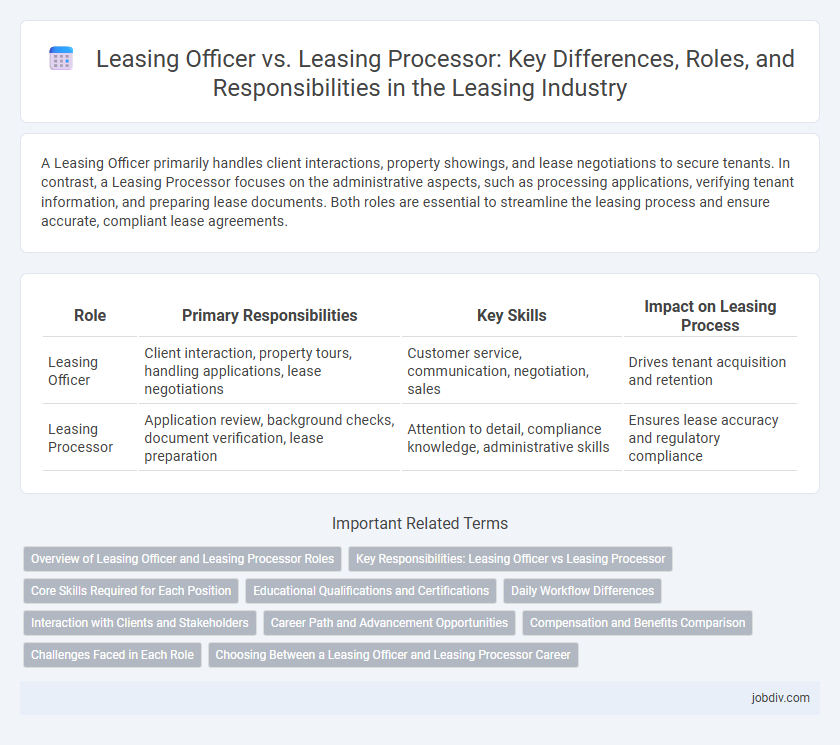A Leasing Officer primarily handles client interactions, property showings, and lease negotiations to secure tenants. In contrast, a Leasing Processor focuses on the administrative aspects, such as processing applications, verifying tenant information, and preparing lease documents. Both roles are essential to streamline the leasing process and ensure accurate, compliant lease agreements.
Table of Comparison
| Role | Primary Responsibilities | Key Skills | Impact on Leasing Process |
|---|---|---|---|
| Leasing Officer | Client interaction, property tours, handling applications, lease negotiations | Customer service, communication, negotiation, sales | Drives tenant acquisition and retention |
| Leasing Processor | Application review, background checks, document verification, lease preparation | Attention to detail, compliance knowledge, administrative skills | Ensures lease accuracy and regulatory compliance |
Overview of Leasing Officer and Leasing Processor Roles
Leasing Officers manage client relations, conduct property tours, and negotiate lease agreements to secure tenants efficiently. Leasing Processors handle administrative tasks, including preparing lease documentation, verifying applicant information, and coordinating lease approvals to ensure compliance and accuracy. Together, these roles streamline the leasing process from tenant acquisition to finalized contracts.
Key Responsibilities: Leasing Officer vs Leasing Processor
Leasing Officers primarily manage tenant relations, conduct property tours, and enforce leasing agreements to ensure occupancy and compliance. Leasing Processors handle application processing, background checks, and documentation to confirm tenant eligibility and prepare lease contracts. Both roles collaborate to streamline leasing operations but focus on distinct stages of the tenant acquisition process.
Core Skills Required for Each Position
Leasing Officers require strong customer service skills, effective communication, and negotiation abilities to secure rental agreements and build client relationships. Leasing Processors must excel in administrative tasks, attention to detail, and proficiency in leasing software to manage applications, prepare lease documents, and ensure regulatory compliance. Both roles demand knowledge of leasing laws, but Leasing Officers focus on interpersonal interactions while Leasing Processors emphasize operational accuracy.
Educational Qualifications and Certifications
Leasing Officers typically require a high school diploma or associate degree, with certifications such as Certified Leasing Professional (CLP) enhancing their credentials. Leasing Processors often hold similar educational qualifications but benefit from specialized training in lease documentation and compliance, such as the National Apartment Association's Certified Apartment Leasing Professional (CALP) certification. Both roles prioritize knowledge of leasing laws and strong organizational skills to ensure efficient lease management and tenant relations.
Daily Workflow Differences
Leasing Officers primarily focus on client interactions, property showings, and lease negotiations to secure tenants, while Leasing Processors manage the administrative tasks such as application processing, background checks, and lease documentation. The Leasing Officer's daily workflow involves building relationships and closing deals, whereas the Leasing Processor ensures compliance and accurate record-keeping behind the scenes. Both roles collaborate closely to facilitate a smooth leasing process but emphasize different operational priorities.
Interaction with Clients and Stakeholders
Leasing Officers directly engage with clients to showcase properties, negotiate lease terms, and address tenant inquiries, ensuring a personalized leasing experience. Leasing Processors collaborate closely with property managers and legal teams to prepare, verify, and process leasing documents, maintaining compliance and accuracy throughout the leasing cycle. Effective communication between Leasing Officers and Leasing Processors streamlines tenant onboarding and enhances client satisfaction.
Career Path and Advancement Opportunities
Leasing Officers typically handle direct client interactions, marketing properties, and securing lease agreements, making this role ideal for those seeking leadership and sales experience in real estate. Leasing Processors focus on the administrative side, managing lease documentation, verifying tenant information, and ensuring compliance, which suits candidates aiming to develop detail-oriented skills and move into property management or legal compliance roles. Career advancement for Leasing Officers often progresses toward Regional Manager or Leasing Manager positions, while Leasing Processors may advance into Lease Administration or Compliance Specialist roles within property management firms.
Compensation and Benefits Comparison
Leasing Officers typically receive higher base salaries due to their direct client interaction and responsibility for securing lease agreements, with average compensation ranging from $45,000 to $60,000 annually. Leasing Processors, while earning a lower base salary between $35,000 and $45,000, often benefit from comprehensive administrative support roles that include structured schedules and enhanced job stability. Benefits for both roles commonly feature health insurance, paid time off, and potential commission bonuses, but Leasing Officers more frequently access performance-based incentives tied to lease closures.
Challenges Faced in Each Role
Leasing Officers often face challenges in tenant acquisition and retention, requiring strong negotiation skills and market knowledge to close deals efficiently. Leasing Processors encounter difficulties in managing extensive paperwork and ensuring compliance with leasing regulations, demanding meticulous attention to detail and organizational skills. Both roles must navigate communication hurdles between clients, landlords, and internal teams to maintain smooth leasing operations.
Choosing Between a Leasing Officer and Leasing Processor Career
Leasing Officers primarily handle client interactions and property showings, making strong communication and sales skills essential. Leasing Processors focus on administrative tasks such as application review, background checks, and lease documentation, requiring attention to detail and organizational proficiency. Choosing between these careers depends on whether you prefer direct tenant engagement and sales-driven roles or behind-the-scenes processing and compliance duties.
Leasing Officer vs Leasing Processor Infographic

 jobdiv.com
jobdiv.com